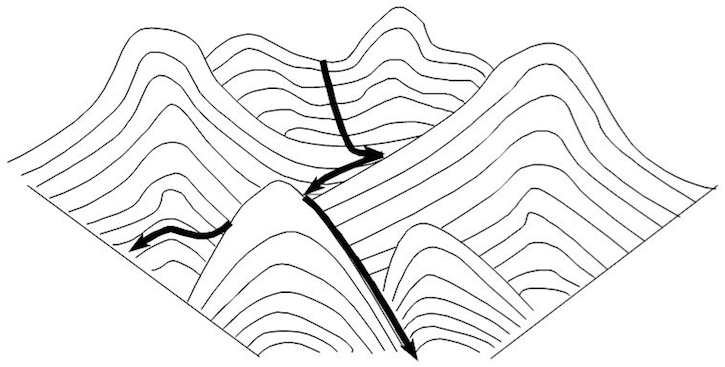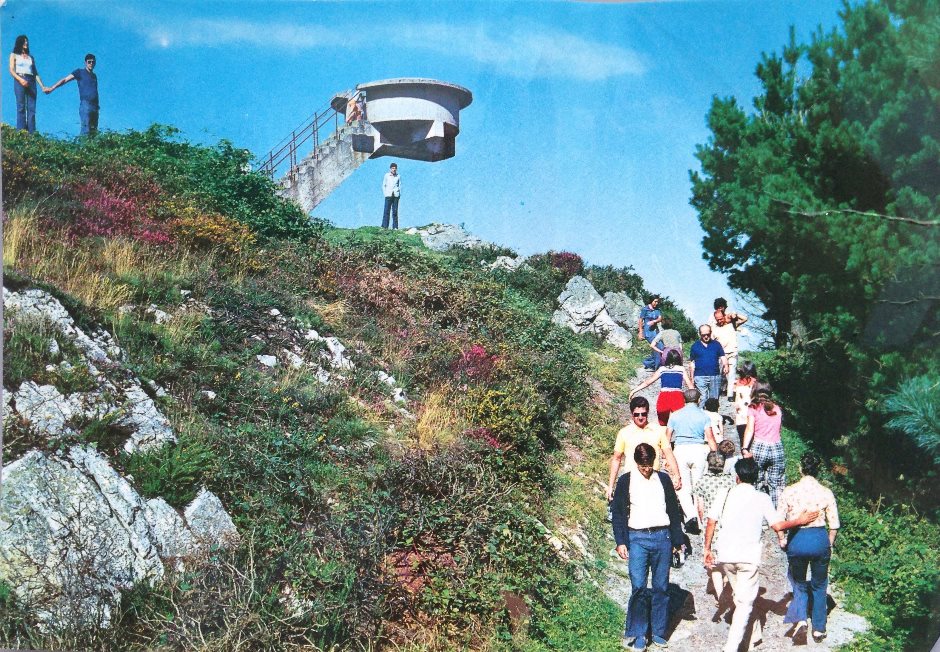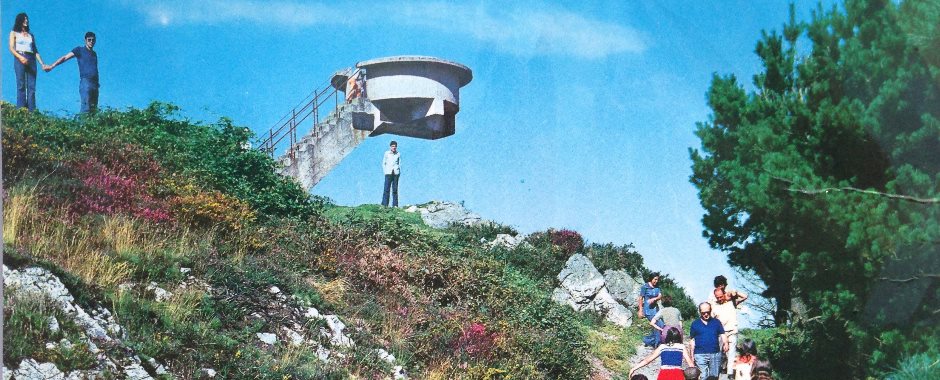Picture this…
I like picture postcards. I like sending them, and I like receiving them. Despite the instantaneous advantages of Telegram and Twitter, or the range of Instagram and Facebook, my liking for postcards sent from A to B endures.
Some I stick on my office wall, including the one above. Stuck above my desk for years, it shows people climbing up to the Mirador del Fitu in Asturias, from where there is a magnificent panorama of the Picos de Europa mountains to the South and the Cantabrian Sea to the North. But despite the view, the postcard manufacturer chose to show the viewpoint instead!
The postcard caught my attention again whilst reading a new collection of Mike Cooley’s writings from the 1990s. In Delinquent Genius: the strange affair of man and his technology, Mike argues how important are the vantage points from which we develop technology – the gendered title, for example, refers to the dominance of male perspectives.
In the book, Mike aims not just to compare positions in order to work out variations on a theme, such as, say, different routes to enhanced labour productivity, competitiveness or economic growth; but rather vantage points for realising neglected human purposes – such as creative work and environmental sustainability – through technology. Looking at the same picture from different angles yields surprising results.
Each of the book’s short chapters takes different vantage points to look upon a period of intense restructuring in the industrial manufacturing landscape, whose effects are still felt today. The 1970s to the 1990s saw the automation of much production activity, and a global restructuring and relocation of manufacturing centres.
Mike was a lucid critic of the business consultants and management theorists promoting this transformation. And he remains so today, arguing how their technologies for scientific management and the workerless factory are dehumanising rather than liberating. He wants us to experience things from a different vantage point:
“Conventionally, a system is only regarded as being scientifically designed if it displays the three predominant characteristics of the natural sciences. That is to say, predictability, repeatability and quantifiability. That by definition precludes intuition, subjective judgement and tacit knowledge. It excludes imagination, emotion and, above all, the intentionality and purpose of the user.”
The range of (connected) ways Mike goes into this is impressive: from its influence in changing relations with our environments and one another, via implications for our notions and experience of time, through to the importance of craft and care in our material cultures, including technology. If there’s a compass that guides this journey across the diverse chapters, then it’s the importance of democracy in developing and deciding between different technological pathways.
Each chapter is like an old postcard from either the fault-lines of automation or the front-line for humane alternatives. Their messages remain deeply resonant for debates about Industry 4.0 today.
Post-automation
In the 1970s and 1980s Mike helped articulate a movement for socially useful production that was attempting a different arrangement for computer-integrated manufacturing: one that viewed the calculative and communicative affordances of computers from a more human-centred rather than human-displacing vantage point.
The movement envisaged a set of computation possibilities that “supports the skill and ingenuity of the user and is amenable … to skilled pro-active workers.” Such aspiration still strikes a chord today.
On the one hand, some of us worry about being surveilled and coerced on the streets of Smart Cities, or in the workplace with wearable monitors and automated task-scheduling that treats us like robots. School classes with one-size-fits-all tech seem to set us misfits up to fail. Predictive Big Data opens up ever more distance between our rights and authority. More generally, apparently universalised criteria for technology (actually coming from Chicago or California) are set in narrow, externalising notions of efficiency, competition and convenience, which seem to crowd out diverse cultural and physical sensitivities.
But on the other hand, and importantly, technologies bring new creative possibilities for people, and help us work and socialise in much more expansive ways. For example, increasingly accessible, open and versatile design and fabrication technologies are themselves capable of being hacked, remade and repurposed.
But it is not the artefacts themselves that are important, so much as the new ways of working and new social relations (pdf) available with these technologies. These relations are ever more widely distributed socially and geographically, and make it possible for production and consumption to become radically decentralized. In these new social relations and arrangements, commitment to commons-based peer-production and sustainable developments jostles with design entrepreneurialism.
The latter simply sees, in the range of new socio-technical possibilities, novel inputs for business as usual – whereas the former anticipates a more sustainable and cooperative political economy.
Intriguingly, many of the digital design and fabrication technologies that permit experimentation today have emerged from the earlier waves of automation in manufacturing. The situations and contexts may change, but the underlying dilemmas and issues in Mike’s arguments endure: how to navigate these turnarounds and tensions?
Socially Useful Production
In the late 1970s and early 1980s, a movement of workers, peace activists, environmentalists, and radical city leaders in the UK mobilised for socially useful production. Industrial restructuring and technological change were threatening livelihoods and communities. As an alternative pathway for development, they promoted prototypes, workshops and strategies that embodied 16 criteria for socially useful production:
- The process by which the product is identified and designed is itself an important part of the total process;
- The means by which it is produced, used and repaired should be non-alienating;
- The nature of the product should be such as to render it as visible and understandable as is possible and compatible with its performance requirements;
- The product should be designed in such a way as to make it repairable;
- The process of manufacture, use and repair should be such as to conserve energy and materials;
- The manufacturing process, the manner in which the product is used and the form of its repair and final disposal should be ecologically desirable and sustainable;
- Products should be considered for their long-term characteristics rather than short-term ones;
- The nature of the products and their means of production should be such as to help and liberate human beings rather than constrain, control and physically or mentally damage them;
- The production should assist cooperation between people as producers and consumers, and between nation states, rather than induce primitive competition;
- Simple, safe, robust design should be regarded as a virtue rather than complex ‘brittle’ systems;
- The product and the processes should be such that they can be controlled by human beings rather than the reverse;
- The product and the processes should be regarded as important more in respect of their use value than their exchange value;
- The products should be such as to assist minorities, disadvantaged groups and those materially or otherwise deprived;
- Products for the Third World which provide for mutually non-exploitative relationships with the developed countries are to be advocated;
- Products and processes should be regarded as part of culture, and as such meet the cultural, historical and other requirements of those who will build and use them;
- In the manufacture of products, and in their use and repair, one should be concerned not merely with production, but with the reproduction of knowledge and competence.
Historical experience reinforces Mike’s point that there is rarely “one best way” for technology. Spaces for critical making and participatory technology occupy different vantage points and see the lie of the land differently, compared to the unreflective views of dominant institutions. Whereas dominant institutions tend to produce what Mike calls ‘present tense technology’ – technologies that perpetuate the status quo – other, more critical viewpoints inform prototypes that radically anticipate different future institutions.
That Mike sees the social and the technological as deeply entwined is nothing new to us today. But Mike’s language and argument comes from a more direct place in technology-society relations compared to, say, academics like me working in Science and Technology Studies (STS). Where STS brings critical reflexivity to debates about Industry 4.0 and so on, Mike’s writings retain the engineer’s desire to rework those concerns into tractable problems that can be practically solved.
Mike’s problem-solving journey began with a childhood spent hanging out in his father’s workshop in Tuam in Galway; from there, he worked as an apprentice in Switzerland and Germany, as a design engineer in Britain, became a doctoral researcher in computer-aided design, then a trades union shop steward involved in the Lucas Plan for socially useful production (see Box). He served as Director of Technology at the Greater London Council in the early 1980s, promoting industrial cooperatives and a network of community prototyping workshops, and was a partner in a European project developing human-centred, computer-integrated manufacturing systems. He has been chair of a European expert group recommending culturally diverse industrial strategy, and a founder of the journal AI & Society.
Diverse spaces
Across all this work, however, Mike and his colleagues were swimming against an ideological tide that was retreating away from explicit deliberation over the human purposes of technology. The rise of the New Right ushered in an automatic preference for market-based decision-making around technology, with the state reduced to underwriting market requirements, rather than orchestrating social deliberation. That social choice took its toll on the spaces available for prototyping alternatives, which were knowingly closed down under the ‘free market’ institutional arrangements.
As Mike notes, alternatives are:
“a potent symbol of paths not taken. It speaks to us of other values and ways of doing things. Its apparent helplessness and vulnerability are deceptive. In its gentle and retreating way, it poses the greatest threat of all, the threat to our self-image.”
Fortunately, new kinds of space are opening up now, and some old ones have persisted. For example, city authorities like Barcelona are promoting policies for digital developments where the citizen is sovereign, and whose platforms presuppose a democratic technological culture quite different to the Silicon Valley ideology. A network of citizen laboratories in Latin America is working on cultivating free culture through grassroots innovation. Cities in every continent have their hackspaces, repair cafés and other facilities where people can open up technology and prototyping local versions. New possibilities are opening up for more creative approaches to designing globally and manufacturing locally.
Sociotechnical landscapes
How far might progressive sociotechnical pathways branch out from these diverse spaces? How do they encounter one another? And how do they fork?
When considering the evolution of pathways, analysts sometimes use topological metaphors like landscapes to evoke the social contours shaping the directions of technology development. In the same period when Mike was writing, Devendra Sahal pictured (in 1985) technological pathways traversing social landscapes. If a technology is to profit and develop it must roll with the social landscape made up of infrastructures, institutions, ideas etc – represented in the picture by the contours, peaks and valleys.

Devendra arrives at his model by analysing the history of aviation technology. He writes how a technology
“can only ascend through the slopes if its form is progressively modified. Eventually, it may reach one of the several hilltops if its form is perfected through a process of constant refinement. The higher the peak, the greater the perfection. Relatedly, the lower the valley, the greater the difficulty of improvement and of leaving a given pathway.”
It was the military aviation industry that the workers at Lucas Aerospace were trying to leave behind, and struggling to strike out from, along more peaceful and socially useful paths. Mike won the Right Livelihood Prize (also known as the alternative Nobel prize) in 1981, and donated the prize money to the Lucas campaign. He recalls a cautionary analogy about topologies from one of his collaborators in the 1980s, the engineer Howard Rosenbrock, and which became known as the ‘the Lushai Hill effect’:
“Our biggest danger lies in what I may perhaps call the Lushai Hill effect. Resting in the evening and looking back over the lower hills, it is easy to say, ‘At every fork we took the right-hand branch, and see how high we have climbed. Taking the right hand must be the only way’. Though, if we had sometimes taken the left-hand branch, we should in all probability be just as high and perhaps in a region which was in other ways richer, more friendly and more fertile.”
Maybe alternative technologists are foolish to continue slogging up against steep social terrain? Donald Mackenzie, a pioneer in STS, does not think so. Writing about the Lucas Plan, he argues (pdf) such journeys do valuable survey work:
“Whatever the eventual success or failure of these efforts to alter the nature of technology, our understanding of how technology changes can only profit from them. For, by making contingency and choice actual rather than merely hypothetical, they throw into ever-sharper light the ways in which social relations shape technical development.”
The terrain becomes visible with such effort. Indeed, the Lucas Aerospace workers were proposing technologies for future landscapes. Understanding the contemporary topology, analysts see the best routes differently: discounting dead-ends or steep ascents, and arguing for or against certain forks in development. Managerial skills for technological orienteering are recommended. Not the political skills for transforming and bringing forth new landscapes.
As Sahal notes at the end of his analysis from over thirty years ago, “The overall topography itself can be altered by a wide variety of socio-economic forces.” The movement for socially useful production knew this much. Their campaigning worked as much on pushing at the social and economic forces for altering the landscape, as on prototyping technologies that would anticipate the new landscape that might emerge.
Efforts by the movement to develop human-centred computer-integrated-manufacturing did end up informing valuable research in human-computer interaction. But ultimately, it didn’t result in the vision of democratised workplaces that was hoped for. Sociotechnical development took paths that moved within the contours for accumulating capital, exercising managerial control, and smooth interfaces with consumer culture.
Maybe now, with more movements pushing for sustainability, just transformations, and open technology, the strong aspirations that remain for creative work and environmental sustainability may yet shift the landscape? Research into sociotechnical transformations over the last decade has gone some way to help navigate such dynamic complexities.
Wish you were here …
One has to take care with these landscape analogies. Each technological path taken already reshapes the topology through which it advances. We can’t exactly retrace our steps, but we can interrogate and learn from the activities that led us to where we are (activists try to Ban the Bomb or convert the military-industrial complex, not unmake them).
In practice, the sociotechnical relations between technology developments and social landscapes are highly complex, dynamic and frequently asymmetric. Each penetrates the other in myriad forms: we design landscapes into our artefacts, and artefacts become part of our landscapes. Indeed, is it even possible to talk about two different technologies moving through the same landscape? Recent explorations (pdf) by Andy Stirling suggest activism will do better by adopting a ‘worm’s-eye view’ that moves through more open topologies, than seeking the panoramic ‘eagle-eye’ vantage point that is more consistent with Sahal’s work.

Which brings me back to postcards – even the strange ones that show the viewpoint rather than the view. We need postcards from wayfarers along sustainable pathways. People exploring technologies for degrowth for example, and reporting back on progress about the kinds of landscaping that would help them along their way. Or maybe they can just tweet? Or write blogposts?
I worry how outdated I appear in my attachment to picture postcards. Perhaps that says something about the current premium for novelty and innovativeness in our technological culture? Maybe that is as it should be in the case of postcards. But when it comes to developments in other technologies, with their augmentations and attenuations of human purpose, creativity and skill, then being construed and dismissed as outdated might be deeply problematic. Looking back to where forks in technology took one path instead of another can be instructive for diversifying vantage points today. What remains as evident now as it did when Mike Cooley was writing, is how important is democracy for this politics of vantage points and the politics of landscaping.
Who knows how long picture postcards will last? The usual technology suspects are building drones to replace my friendly postwoman, and delivery workers are already monitored, tracked and scheduled as though they were robots.
When looked at in terms of speed and reach (and surveillance), social media wins hands down. But when considered from other vantage points, perhaps picture postcards still hold something of value in human relations? What seems like hassle is also an accomplishment: you have to find a shop still selling postcards in the unfamiliar places being visited, you choose between a limited range of highly professional and amusingly dreadful images, you find a pen to write your message, and you ask for help finding stamps and learning where to post the card.
There’s also something about receiving from others a beautiful little poem or imaginative drawing that comes physically from the sender in the place pictured – and can reach the half of humanity still offline.
More invested with effort: postcards mediate care differently. That is what Mike’s book is about: how to put more care into our technologies?
Delinquent Genius is published by Spokesman Books, who have also republished an earlier collection of Mike Cooley’s writings called Architect or Bee?
Adrian Smith is Professor of Technology & Society at the Science Policy Research Unit (SPRU), University of Sussex, and visiting researcher at the Centro de Innovación en Tecnología para el Desarrollo Human, Universidad Politécnica de Madrid. He is on Twitter as @smithadrianpaul

very good posts on sociotechnical landscapes and digital design . very good informative one.